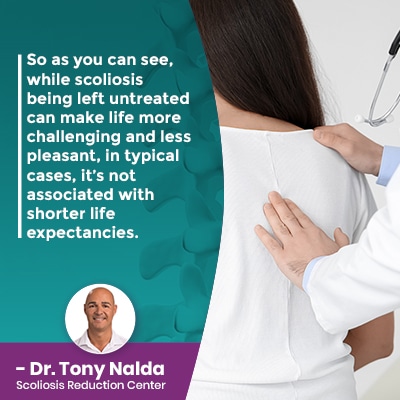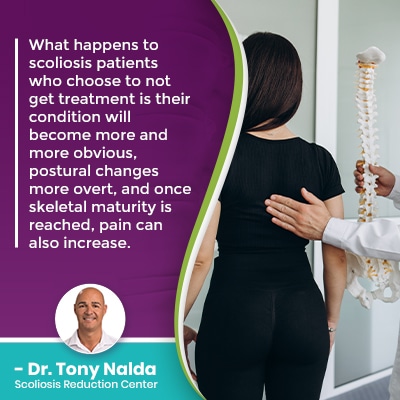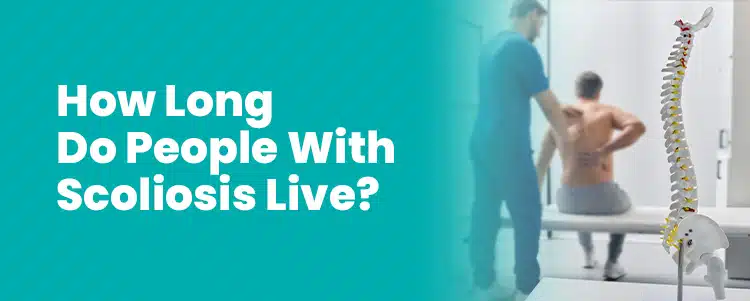There was a time, not too long ago, when people diagnosed with scoliosis were thought to lead shorter lives of limitations, but that has since changed, and we now know that people can thrive, despite being diagnosed with a progressive spinal condition; one only has to look at Usain Bolt, the world’s fastest man, to know that scoliosis doesn’t have to slow people down.
People can thrive with scoliosis, particularly those whose conditions are detected early and treated proactively. When it comes to mortality rates associated with scoliosis, this is difficult to determine and varies based on patient age, condition type, severity, and treatment response.
On its own, scoliosis is not a life-threatening condition, but it is progressive, and if left untreated, it can lead to potential complications that can disrupt quality of life.
What is Scoliosis?
Scoliosis is the development of an unnatural sideways spinal curve that twists (rotational component), and in order to be diagnosed as scoliosis, the unnatural spinal curve also has to be of a minimum size: Cobb angle measurement of at least 10 degrees.
One of the reasons it’s difficult to monitor and report on the mortality of scoliosis patients is because the condition can range so widely in severity: mild to moderate and severe to very severe.
The more severe a condition, the larger the size of the unnatural spinal curve is, the more out of alignment the spine is, the more likely it is to progress, and the more obvious its effects are going to be.
As a progressive condition, scoliosis has it in its nature to get worse over time; only proactive treatment can work towards counteracting the condition’s progressive nature.
Scoliosis diagnosed as mild can easily progress to become moderate, severe, or very severe over time.
Scoliosis can also affect all ages from babies to the elderly and every age in between, so again, it’s difficult to monitor how scoliosis affects the mortality of different age groups, and the older patients get, the more likely it is that other health issues are going to factor into life expectancy rates.
So as I said that scoliosis isn’t a life-threatening condition, but it is progressive, what does scoliosis getting worse actually mean?
How Does Scoliosis Progress?
Scoliosis progressing means that the unnatural spinal curve is increasing in size, and this makes the spine more rigid, less responsive to treatment, and makes patients less able to perform certain therapeutic exercises and stretches that are key facets of treatment.
As scoliosis is progressing, the condition’s uneven forces are also increasing, as are their effects, so what are the condition’s main effects, particularly as they’re not life-threatening?
As mentioned, the condition affects all ages, and patient age is a factor that shapes a patient’s experience of life with the condition; additional factors include condition severity, curvature location, and condition type.
The main symptom of scoliosis in children and adolescents is postural deviation, and this is caused by the condition’s uneven forces disrupting the body’s overall symmetry:
- Uneven shoulders
- Uneven shoulder blades
- The development of a rib arch
- Un uneven waistline
- Uneven hips
- Arms and legs that appear to hang at different lengths
In addition to the aforementioned postural changes associated with scoliosis, changes to gait, balance, and coordination are also common, as is clothing suddenly seeming ill-fitting.
When patients come in to see me for a diagnosis, I can tell a lot about their condition by the way they walk, and when in a forward-bend position, postural changes, the spine’s unnatural curve, and rotation are far more visible.
As scoliosis progresses in children who have not yet reached skeletal maturity, scoliosis getting worse means the postural effects are likely going to become more noticeable, but this isn’t life-threatening.
So what are the main signs of scoliosis in older patients who have reached skeletal maturity?
Symptoms of Adult Scoliosis
Scoliosis doesn’t become a compressive condition until adulthood once skeletal maturity has been reached, and this also means that progression tends to slow down; the trigger for progression is growth and development.
When spines are growing, they are undergoing a constant lengthening motion, and this counteracts the compressive force of a scoliotic curve, which is why scoliosis isn’t commonly described as painful for children, but pain is the main symptom of scoliosis in adults.
While adults experience postural changes too, pain is the main reason adults come to see for a diagnosis and treatment, and this can include back pain and nerve-related pain felt in the body’s extremities.
When scoliosis becomes a compressive condition, it not only affects the spine itself, but also its surrounding muscles and nerves.
So scoliosis getting worse in adults means increasing levels of postural deviation and pain: neither of which are life-threatening.
But what if scoliosis is left untreated, and the curve is allowed to progress unimpeded?
What Happens to Untreated Scoliosis Patients?

As a progressive condition, scoliosis is virtually guaranteed to get worse at some point, but even in severe and very-severe cases, scoliosis isn’t commonly known to be life-threatening.
What happens to scoliosis patients who choose to not get treatment is their condition will become more and more obvious, postural changes more overt, and once skeletal maturity is reached, pain can also increase.
Now, in particularly severe cases, if left untreated, scoliosis can lead to complications that can impact quality of life such as headaches, digestive issues, and lung impairment.
When it comes to headaches, we’re talking about headaches that can reach migraine status, and this is due to disruptions in the flow of cerebrospinal fluid in and around the brain.
Digestive issues can develop due for a number of reasons that include structural, nerve, and muscle changes, and when it comes to lung impairment, this is particularly related to thoracic scoliosis and is caused by the unnatural spinal curve pulling on the rib cage, and causing a loss of space for the lungs to function optimally within.
Even in severe cases, however, lung impairment is only likely noticeable to professional athletes and/or those who place higher-than-average demands on their respiratory systems.
So as you can see, while scoliosis being left untreated can make life more challenging and less pleasant, in typical cases, it’s not associated with shorter life expectancies.
In addition, there are different types of scoliosis, and atypical forms such as neuromuscular, congenital, and degenerative scoliosis are associated with higher levels of complications.
In atypical scoliosis cases, other factors are guiding patients’ lives such as the presence of a larger neuromuscular condition that causes the scoliosis to develop, or other birth abnormalities that tend to accompany a malformed spine, and in cases of degenerative scoliosis, we’re talking about adults over the age of 50 who are likely dealing with other healthy conditions/issues.

So while scoliosis itself isn’t associated with a lower life expectancy, a surgical response to scoliosis can increase the risk of complications that can be life-threatening, but again, this is more related to how scoliosis is responded to with treatment, than the condition itself.
Conclusion
People with scoliosis can lead long and fulfilling lives, as many celebrities and professional athletes do, despite being diagnosed with the progressive spinal condition.
It’s natural for people recently diagnosed to wonder if the condition is associated with a lower life expectancy, but the body is remarkably adept at adjusting to a number of conditions, scoliosis being one of them.
In many cases, scoliosis can be difficult to diagnose, particularly in young patients for whom the condition is not yet progressive and painful, so it’s not uncommon that people have scoliosis for years without being aware, only to receive a diagnosis years later in adulthood.
While some atypical forms of scoliosis are more disruptive to quality of life and are more associated with lower life expectancy such as neuromuscular scoliosis, this is more related to the underlying neuromuscular condition causing the scoliosis, than the actual scoliosis itself.
However, for those on the path of traditional scoliosis treatment, spinal fusion surgery is associated with complications that can impact a patient’s life expectancy, so a surgical response should be considered carefully.
Here at the Scoliosis reduction Center, I approach each and every diagnosis of scoliosis with proactive treatment that has the potential to impact scoliosis on every level for long-term sustainable treatment results.
When it comes to minimizing the effects of a condition like scoliosis, the key is a proactive response that works towards preventing progression so increasing condition severity, escalating symptoms, and the risks associated with developing certain complications, and the need for invasive surgical treatment, are avoided.




